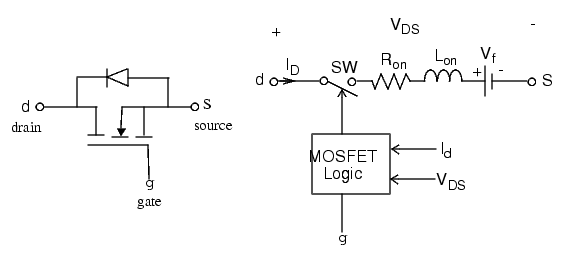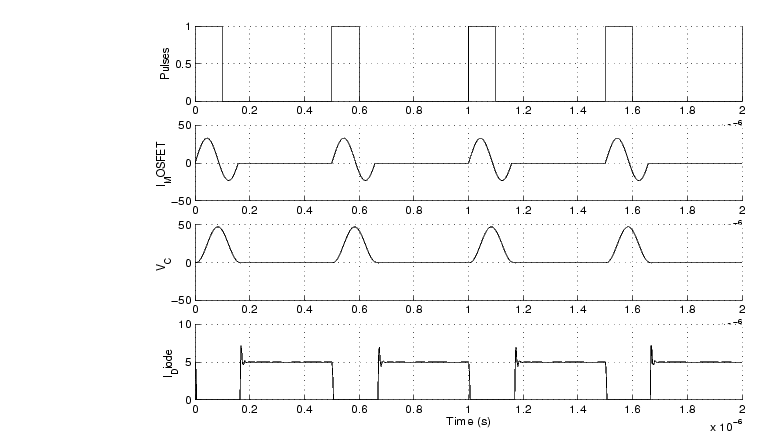

| SimPowerSystems |   |
Library
Description![]()
The metal-oxide semiconductor field-effect transistor (MOSFET) is a semiconductor device controllable by the gate signal (g > 0) if its current Id is positive (Id > 0). The MOSFET device is connected in parallel with an internal diode that turns on when the MOSFET device is reverse biased (Vds < 0). The model is simulated as a series combination of a variable resistor (Rt) and inductor (Lon) in series with a switch controlled by a logical signal (G > 0 or g = 0).

The MOSFET device turns on when the drain-source voltage is positive and a positive signal is applied at the gate input (g > 0).
With a positive current flowing through the device, the MOSFET turns off when the gate input becomes 0. If the current Id is negative (Id flowing in the internal diode) and without a gate signal (g = 0), the MOSFET turns off when the current Id becomes 0 (Id = 0).
Note that the on state resistance Rt depends on the drain current direction:
The MOSFET block also contains a series Rs-Cs snubber circuit that can be connected in parallel with the MOSFET (between nodes d and s).
Dialog Box and Parameters
 ).
). 0. ).
). ). Set the Snubber resistance Rs parameter to
). Set the Snubber resistance Rs parameter to inf to eliminate the snubber from the model. 0 to eliminate the snubber, or to inf to get a resistive snubber.Inputs and Outputs
The input port is a logical signal applied to the gate. The output port is a measurement vector [Id Vds] returning the MOSFET device current and voltage.
Assumptions and Limitations
The MOSFET block implements a macromodel of the real MOSFET device. It does not take into account either the geometry of the device or the complex physical processes [1].
The MOSFET block is modeled as a current source. It cannot be connected in series with an inductor, a current source, or an open circuit, unless its snubber circuit is in use. In order to avoid an algebraic loop, you cannot set the MOSFET block inductance Lon to 0. Each MOSFET block adds an extra state to the electrical circuit model. See Advanced Topics, for more details on this topic.
Circuits containing individual MOSFET blocks cannot be discretized. However discretization is permitted for MOSFET/Diode bridges simulated with the Universal Bridge block.
You must use a stiff integrator algorithm to simulate circuits containing MOSFETs. ode23tb or ode15s with default parameters usually gives the best simulation speed.
Example
The psbmosconv.mdl demo illustrates the use of the MOSFET block in a 0-current quasi-resonant switch converter. In such a converter, the current produced by the Lr-Cr resonant circuit flows through the MOSFET and internal diode. The negative current flows through the internal diode that turns off at 0 current [1]. The switching frequency is 2 MHz and the pulse width is 72 degrees (duty cycle: 20%).
Run the simulation and observe the gate pulse signal, the MOSFET current, the capacitor voltage, and the diode current on the four-trace Scope block. Also observe the state-plane trajectory (inductor current versus capacitor voltage).
References
[1] Mohan, N., T.M. Undeland, and W.P. Robbins, Power Electronics: Converters, Applications, and Design, John Wiley & Sons, Inc., New York, 1995.
See Also
Diode, GTO, Ideal Switch, Thyristor
 | Linear Transformer | Multiband Power System Stabilizer |  |